The 2013 International Forum on Peaceful Use of Nuclear Energy, Nuclear Non-Proliferation and Nuclear Security
- Ensuring Nuclear Non-Proliferation and Nuclear Security of Nuclear Fuel Cycle Options in consideration of the Accident at TEPCO's Fukushima Daiichi Nuclear Power Station -
Opening Remarks
Mr. Shojiro Matsuura, JAEA President
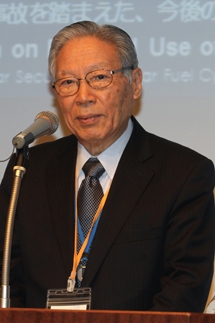 Mr. Shojiro Matsuura
Mr. Shojiro MatsuuraSince the accident at TEPCO's Fukushima Daiichi Nuclear Power Station on March 11, 2011, Japan has been reviewing its energy policy, which includes nuclear energy policy. As Japan's only comprehensive nuclear research and development institution, the JAEA is committed to providing assistance in dealing with the aftermath of this nuclear accident, and to conducting pertinent research and development. We should lead the efforts to restore public trust in nuclear energy. Nevertheless, the JAEA caused a series of deeply regrettable scandals: flawed maintenance discovered at fast reactor Monju; a radioactive leak at a high-intensity proton accelerator facility called Japan Proton Accelerator Research Complex (J-PARC); and a breach of the nuclear physical protection program at Monju. Determined to carry out reforms in accordance with the JAEA reform plans, we have defined the year starting from this October as the year of intensive reforms. We intend to pursue "the way of safety" in particular, which embodies "integrity: completeness, unity, honesty" with strong perseverance.
This year's International Forum focuses on how to ensure nuclear non-proliferation and nuclear security in the context of options for the nuclear fuel cycle, with the accident at TEPCO's Fukushima Daiichi Nuclear Power Station in mind. Through discussions among the experts about risks and countermeasures involved in efforts toward nuclear non-proliferation and nuclear security, it aims to offer an invaluable background for discussions about visions of the nuclear fuel cycle, both open fuel cycle and closed fuel cycle. Debates over these challenging issues cannot be wrapped up in a day or two, but I hope that vibrant discussions among the experts will help deepen our understanding of the problems that must be addressed for the future of nuclear energy.
Keynote Speeches
Japan's energy policy in consideration of the Accident at TEPCO's Fukushima Daiichi Nuclear Power Station
Mr. Yojiro Hatakeyama, Director, Nuclear Energy Policy Planning Division, Electricity and Gas Industry Department, Agency for Natural Resources and Energy, Ministry of Economy, Trade and Industry
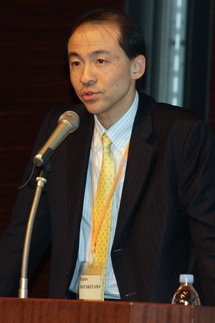 Mr. Yojiro Hatakeyama
Mr. Yojiro HatakeyamaAfter the oil crises in the 1970, Japan worked to reduce its dependence on oil. Since the accident at TEPCO's Fukushima Daiichi Nuclear Power Station on March 11, 2011, however, the country has increased its dependence on oil and natural gas for thermal power generation as an alternative to nuclear power generation because nuclear reactors across the country had to be shut down (about 90 percent of electricity was generated from fossil fuels in FY 2013). This situation involves a risk different from that of a nuclear accident. A good part of fossil fuels that Japan imports from the Middle East is shipped via the Strait of Hormuz, so, if any crisis—a blockade, for example—arose, about 80 percent of oil and 30 percent of natural gas that Japan imports would become unavailable. It is estimated that fuel costs rose by 3.6 trillion yen during FY 2013 owing to thermal power generation that increased after the shutdowns of nuclear power plants, and the rising fuel costs have been putting pressure on electric power companies to hike electricity rates. Besides, the increased thermal power generation has boosted greenhouse gas emissions that cause global warming (an increase of 110 million tons in CO2, which equates to 9 percent of CO2 emissions across Japan).
Of all the problems that arose after the accident at TEPCO's Fukushima Daiichi Nuclear Power Station , the issue of contaminated water has increased in severity and must be solved urgently. The Japanese government intends to work on the frontline to carry out required measures, rather than leaving everything in the hands of TEPCO. Under the principles of eliminating the source of contamination, keeping water away from the source, and keeping contaminated water from leaking, the government will be carrying out drastic multilayered measures, coupled with a course of emergency action plans. In addition, the International Research Institute for Nuclear Decommissioning (IRID) took the lead in setting up a team consisting of experts from both Japan and overseas. In response to the team's call for technical suggestions, about 780 proposals were submitted, with 30 percent of them received from overseas. The experts are currently reviewing these suggestions so that the ideas will be incorporated into the entire picture of preventive and multilayered measures against contaminated water. The other day, they moved on to Phase 2 of the mid- and long-term road map toward the safe decommissioning when the fuel in the spent fuel pool in Unit 4 began to be removed. During Phase 2, they will prepare for fuel debris retrieval, and then they will work on decommissioning, which involves fuel debris retrieval, during Phase 3, the final stage.
The accident at the Fukushima Daiichi Nuclear Power Station revealed these problems: promotional role and regulatory role for nuclear energy use were not completely separated; the government had so much confidence in the safety of nuclear power generation that nuclear safety regulation has not functioned effectively; and the government was incapable of taking prompt action when the large-scale nuclear accident happened. To rebuild the nuclear regulatory system and to restore public trust, which had fallen significantly, the Nuclear Regulation Authority was established on September 19, 2012. The authority examined lessons learned from this accident along with the latest knowledge and information from across the world, and drew up "the New Regulatory Requirements," which took effect on July 8, 2013. Conventional regulatory requirements had been meant to prevent severe accidents, but the newly created requirements cover what to do if a severe accident occurs, in addition to more rigorous measures to prevent accidents and to deal with earthquakes and tsunamis. Currently, seven nuclear power plants and fourteen nuclear reactors are being reviewed for their compliance with the new requirements.
The government takes the basic stance that nuclear power plants should be reactivated if they meet the high safety standards set by the Nuclear Regulation Authority, while the Abe administration has announced that its energy policy aims to reduce the percentage of nuclear power generation.
The Basic Energy Plan, which has been developed in accordance with the Basic Act on Energy Policy, should state comprehensive measures pertinent to energy supply and demand. The Minister of Economy, Trade and Industry will develop a draft of the plan based on views and opinions from the Advisory Committee for Natural Resources and Energy, and then the draft must be approved by the cabinet. To develop a responsible energy policy, the Basic Policy Subcommittee of the Advisory Committee for Natural Resources and Energy has been discussing the Basic Energy Plan, intending to wrap it up by the end of the year. No decision has been made on whether to specify a percentage of nuclear power generation in the plan.
Partnering with Japan to Ensure Nuclear Nonproliferation and Nuclear Security
Mr. Thomas Countryman, Assistant Secretary of State for International Security and Nonproliferation, United States
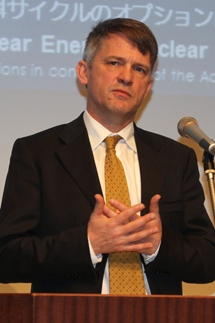 Mr. Thomas Countryman
Mr. Thomas CountrymanIn the speech he delivered in Prague in 2009, President Obama called for the three specific steps to seek the peace and security of a world without nuclear weapons: (1) Aim to reduce nuclear weapons, (2) Strengthen the Treaty on the Non-proliferation of Nuclear Weapons (NPT), and (3) Ensure that terrorists have no access to nuclear weapons.
To show its commitment to seek a world without nuclear weapons, the United States signed and ratified the Treaty on Measures for the Further Reduction and Limitation of Strategic Offensive Arms (New START) with Russia. The two nations agreed to reduce their deployed strategic nuclear warheads to 1,550 by 2018. The administration is working to gain more support for ratification of the Comprehensive Nuclear-Test-Ban Treaty (CTBT) by the US Senate, and is continuing its diplomatic efforts to find steps toward concluding a Fissile Material Cutoff Treaty.
The NPT still serves as the foundation of the United States' nuclear non-proliferation policy. At the 2010 NPT Review Conference, the United States worked closely with the other member countries and made sure that these nations have confidence in the NPT regime. Consequently, for the first time in ten years, all NPT member states reached a consensus and successfully adopted the final document. This final document is a detailed action plan that encompasses all the three pillars of the NPT: nuclear disarmament, nuclear non-proliferation, and peaceful uses of nuclear energy. The action plan refers to the IAEA Peaceful Use Initiative (PUI). This initiative was launched by the United States to raise $100 million over four years, and more than 120 NPT member states benefit from the PUI.
Nuclear disarmament, nuclear non-proliferation, and peaceful uses of nuclear energy are the three pillars of the NPT. Since these pillars are meant to reinforce each other, they must be pursued in parallel. Today, while many countries are technically capable of developing nuclear weapons, nearly 190 member states agree to prevent the proliferation of nuclear weapons. The problem is, however, some nations have no intention to comply with the NPT, such as North Korea, Iran, and Syria. Iran made some progress recently, though. The IAEA and Iran signed a joint statement on a framework for cooperation, and, ten days ago, the IAEA and P5+11 agreed to stop Iran's nuclear program from advancing, and to ease some of the sanctions on Iran in exchange for immediate measures intended to reduce the activities in some aspects. They now plan to start negotiations toward a permanent agreement within six months to get Iran to fully comply with the NPT obligations. As for North Korea, the United States has the same policy objectives as before, namely, verifiable denuclearization of the Korean Peninsula in a peaceful manner. There is no way the United States would accept North Korea as a nuclear state. We will work with the partner countries in the Six-Party Talks and with the international community to ensure that North Korea will meet the commitment that it announced in the joint statement in September 2005 and comply with the United Nations Security Council resolutions, and to impede DPRK's proliferation activities.
To prevent terrorists from obtaining nuclear weapons, the United States has been working with countries that own nuclear material and radioactive substances to promote various mechanisms that include the Nuclear Security Summit and the Global Initiative to Combat Nuclear Terrorism. A broad range of measures have been taken through these mechanisms, such as ensuring the security of nuclear material and radioactive substances across the globe, enhancing these countries' law enforcement capabilities pertaining to border controls and illegal trafficking, minimizing the use of highly enriched uranium in all nuclear reactors, and exchanging information about nuclear security via the Center of Excellence (CoE). Consequently, three tons of vulnerable highly enriched uranium and plutonium have been eliminated or disposed of since the process of the Nuclear Security Summit began. The world as a whole is becoming more capable of working to prevent nuclear terrorism, and we will continue the efforts into the third Nuclear Security Summit to be held next year in the Netherlands.
Japan is the United States' important partner in all areas of activities to promote nuclear non-proliferation. The two countries work together at the United Nations and the IAEA, at a regional level, in multilateral frameworks, and in the bilateral framework. The cooperative relationship between Japan and the United States in the field of peaceful uses of nuclear energy has blossomed, especially since the Agreement for Cooperation between the Government of Japan and the Government of the United States of America Concerning Peaceful Uses of Nuclear Energy was renewed in 1988.
Japan has been taking the lead in strengthening the safeguards system and promoting nuclear safety and security, and is an important partner in the PUI. We highly appreciate the technical cooperation between Japan and the United States, especially the efforts that involved the IAEA to explore safeguards at the Rokkasho Reprocessing Plant and other plutonium handling facilities. We also support and value the policy of "no surplus plutonium" that Japan has announced.
We understand that Japan is facing a difficult situation surrounding its energy policy. Japan needs to make responsible decisions about how to proceed with nuclear energy, and present the decisions not only to the Japanese public but also to its overseas partners. As Japan's partner, the United States expects the following when Japan implements its policy on the back end of the nuclear fuel cycle, and when it explores policies regarding the Rokkasho Reprocessing Plant and the disposition of plutonium in particular: (1) Openess and transparency, (2) Clear-eyed view of technical and economic realities as well as political realities, and (3) To consider the implication that Japan's policy on the nuclear fuel cycle may have on the regional and global efforts toward nuclear non-proliferation.
Finally, with regard to nuclear security, I would like to add that there has been dramatic progress in nuclear security capabilities at all the facilities in Japan. Also, the CoE2 that Japan set up started operating. It has been making significant contributions to the countries in the region.
1 The permanent members of the UN Security Council (the US, Russia, the UK, France, China) and Germany.
2 Integrated Support Center for Nuclear Non-proliferation and Nuclear Security run by the Japan Atomic Energy Agency.
French nuclear fuel cycle policy and its international efforts for ensuring nuclear non-proliferation
Mr. Frédéric Journes, Director of Strategy and International Affairs of the Alternative Energies and Atomic Energy Commission (CEA) and Governor for France to the IAEA
(Mr. Christophe Xerri, Nuclear Counsellor at the Embassy of France in Japan, will read the speech on behalf of Mr. Journes)
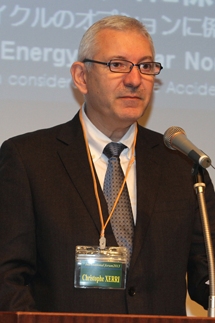 Mr. Christophe Xerri
Mr. Christophe XerriWhile the change of government as a result of the presidential election a year and half ago will likely influence France's energy mix, nuclear energy and the closed cycle will continue to play central roles. The La Hague site and the Melox plant for MOX fuel fabrication will continue to operate, and the recycling of spent fuel will be maintained. With regard to nuclear disarmament and nuclear non-proliferation, France will remain committed to reducing nuclear weapons and the following efforts toward nuclear non-proliferation:
- Giving the highest priority to the promotion of nuclear non-proliferation.
- Supporting the IAEA's missions, and the signing and implementation of the Additional Protocol in particular.
- Requiring compliance with obligations to prevent nuclear proliferation when nuclear material and equipment are exported.
- Continuing to provide services relating to spent fuel management; supporting an open and flexible international market for enrichment services.
- Demonstrating the nation's commitment to the CTBT; complying with the voluntary decision not to produce any fissile material for nuclear weapons.
- Maintain the nation's stance toward Iran, North Korea, and Syria.
To prevent nuclear proliferation amid the increasing use of nuclear energy across the world, technical, legal or institutional and political or commercial measures should be taken.
- Technical measures as the first barrier
Fissile material used for nuclear power generation are not suited to nuclear weapons, so nuclear power generation in itself is not a threat to efforts toward nuclear non-proliferation. Uranium is enriched to 5 percent for nuclear power generation, and, to build a nuclear warhead, it needs to be enriched to 90 percent. Besides, nuclear power generation that uses low enriched uranium is not the preferred option for obtaining weapon-grade plutonium. With regard to the latter point, to further enhance the proliferation resistance, France's nuclear power industry has been developing high burn-up fuel.
- Legal or regulatory measures as the second barrier
IAEA safeguards is an effective means to prevent nuclear proliferation. France is supporting the Additional Protocol and the State-Level Concept, and consider strict export control regimes to be vital. In this light, France support India's participation in the Nuclear Suppliers Group (NSG), since India is a potential supplier of nuclear material and equipment.
- Political and commercial measures as the third barrier
A nation that intends to acquire nuclear weapons needs either enrichment technology or reprocessing technology. In this light, the most efficient measure against nuclear proliferation is to provide these services so that most states do not need to have its own nuclear fuel cycle facilities.
Front end
It is vital that only a limited number of enrichment plants are capable of providing enrichment services that fulfill worldwide demand, and that no other factors than a lack of non-proliferation credentials block the supply of fuel. The best solution to this issue is an approach based on a transparent market based approach where the IAEA acts as the rating agency. The current market already provides high-level security of supply. The IAEA is developing a fuel bank that will guarantee additional fuel supplies.
Back end
Plutonium contained in spent fuel becomes less attractive as material for nuclear weapons when its burn-up is high. It can be even less attractive through recycling the spent fuel. Ideally, all spent fuel should be reprocessed and recycled, processed into MOX fuel in plants under IAEA safeguards, and used in light-water reactors, or fast reactors in the future. As EDF already ensures this, the volume of spent fuel to be reprocessed and that of plutonium to be used as MOX fuel should be balanced so that inventories of separated plutonium will not increase. On the other hand, direct disposal of spent fuel involves the difficult issue of how to ensure long-term safeguards.
The world does not need many reprocessing plants. A limited number of reprocessing plants on a regional basis could be an appropriate path.
Enhancing nuclear proliferation resistance in reprocessing and recycling remains a priority, and France, Japan, and other countries have continued their research on it. Developing fast reactors will also contribute to achieving the goal of nuclear non-proliferation. Fast reactors function as breeder reactors when the world needs more energy, and as plutonium and actinide burner reactors when society gives priority to waste management.
Meeting Safeguards Challenges
Mr. Tero Varjoranta, Deputy Director General and Head of the Department of Safeguards, International Atomic Energy Agency (IAEA)
(Mr. Davis Hurt, Head of the IAEA Tokyo Regional Office, will read the speech on behalf of Mr. Varjoranta)
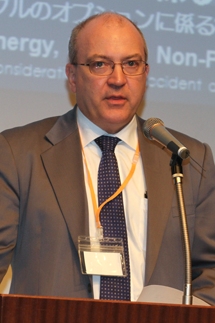 Mr. Davis Hurt
Mr. Davis HurtWith the interest in nuclear energy growing across the world even after the accident at TEPCO's Fukushima Daiichi Nuclear Power Station, the number of plants under IAEA safeguards has been on the increase. What we should be concerned about here is that sensitive nuclear activities, such as uranium enrichment and reprocessing, may proliferate. Smuggling nuclear-related technologies is becoming increasingly easier as trade has been globalized, making national borders disappear, and there is growing concern that sensitive information may be leaked into the Internet. Against this backdrop, demand for IAEA safeguards has been growing and become more complex. On the other hand, since the budget for IAEA safeguards cannot be expected to grow, resources should be used for specific purposes in a more strategic manner. For example, myriad skills and resources are needed to deal with a "problem case" like today's Iran.
The exposure of Iraq's clandestine nuclear weapons development plans about 20 years ago set the stage for adopting the Additional Protocol; however, the Protocol has not been ratified by all the member states. It is imperative for all the states to ratify the Additional Protocol so that the IAEA will reach the conclusion that all nuclear material are used for peaceful purposes. Therefore, making the Additional Protocol universal is the major political issue.
New technologies, such as environmental sampling and satellite images, have made more safeguards-related information available over the last 20 years, which has contributed to the efficient and effective IAEA safeguards implementation. What is essential here is that we should explain our activities in an open and transparent manner to maintain trust from the member states. In addition, we must maintain our reliability by exercising the IAEA's authority robustly and with impartiality. There is no way the IAEA would compromise when it deals with noncompliance. Director General Amano is clear and consistent about this policy.
While the IAEA has faced difficulties in the application of safeguards to North Korea, Syria and Iran, there has been progress on the safeguards applied to Iran. The IAEA and Iran signed a joint statement on a framework for cooperation, intending to work toward solving problems in phases. In the statement, Iran agreed to implement six measures over the next three months, such as providing a wider range of information about plans for nuclear facilities and nuclear activities, and granting access to uranium mines and heavy water production facilities.
When I became Deputy Director General and Head of the Department of Safeguards in October, I determined to enhance the effectiveness and efficiency of IAEA safeguards by promoting the State-Level Concept, which evaluates a member state's nuclear program and nuclear energy-related activities as a whole. This approach enables us to give more comprehensive and advanced evaluations of the country's nuclear programthrough the use of a wide range of safeguards-related information, including environmental samples, satellite images, publicly available information, procurement information, and, if the country is a signatory of the Additional Protocol, information gained through complementary access.
The implementation of the Additional Protocol has made it easier to develop a full picture of each member state's nuclear power project. Further optimizing the implementation of IAEA safeguards makes the conduct of safeguards effective and efficient, which benefits both the member states and the IAEA.
In trying to optimize the implementation of the safeguards system in the member states the relationship between IAEA and national and regional safeguards authority will lead to consequences favorable to both sides, such as fewer field verification activities. Some insist that adopting the State-Level Concept will lead the safeguards system to "discriminate" against certain member states, yet it is inevitable that the characteristics and the scale of the nation's nuclear activities influence the application of safeguards. To dispel the concern that "differentiation"of the safeguards may lead to "discrimination," the IAEA has adopted a clear and highly transparent process for developing a safeguards approach for each country.
To improve cost-effectiveness, we need to keep investing in the best available equipment and technologies for safeguards. The Department of Safeguards has been improving extensively on its IT system so that it will perform its work more effectively and efficiently. In Seibersdorf, Austria, a project called ECAS is in progress to build a new laboratory for analyzing samples of nuclear material.
My vision for safeguards in the future is one in which we continue to draw independent, robust and soundly-based conclusions safeguards based on a comprehensive evaluation of all available safeguards-relevant information, and in which non-compliance is firmly dealt with.
Panel Discussion 1
"Nuclear non-proliferation and nuclear security measures of nuclear fuel cycle options in consideration of the Accident at TEPCO's Fukushima Daiichi Nuclear Power Station"

- Chairperson
- Mr. Tetsuya Endo, Ambassador, Adjunct Senior Fellow, The Japan Institute of International Affairs / Former Vice Chairman, Atomic Energy Commission of Japan
- Panelists
- Mr. Thomas Countryman, Assistant Secretary of State for International Security and Nonproliferation, United States
- Mr. Robert Einhorn, Senior Fellow, Brookings Institution
- Mr. Davis Hurt, Head of the IAEA Tokyo Regional Office
- Mr. Christophe Xerri, Nuclear Counsellor at the Embassy of France in Japan
- Prof. Hajimu Yamana, The Kyoto University Research Reactor Institute (KURRI)
- Mr. Toshiro Mochiji, Director, Department of Science and Technology for Nuclear Material Management (STNM) / Deputy Director, Integrated Support Center for Nuclear Nonproliferation and Nuclear Security (ISCN), JAEA
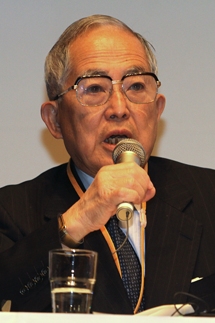 Mr. Tetsuya Endo
Mr. Tetsuya EndoDiscussion Points
- Impacts of the accident at TEPCO's Fukushima Daiichi Nuclear Power Station on nuclear energy utilization
- Challenges and measures to overcome such challenges for ensuring nuclear non-proliferation and nuclear security of fuel cycle options
Summary of Panel Discussion
Based on the implication of the Accident at TEPCO's Fukushima Daiichi Nuclear Power Station on the use of nuclear energy in Japan and overseas, as well as on the increased interest in the back end of the nuclear fuel cycle, the discussion was made on the nuclear non-proliferation and nuclear security challenges and measures needed to overcome such challenges accompanying two nuclear cycle options, open fuel cycle and closed fuel cycle, from the policy and institutional perspectives.
The discussion opened with Mr. Toshiro Mochiji (JAEA)'s explanation about the impact of the nuclear accident on Japan's nuclear policy and issues that must be addressed, followed by Mr. Thomas Countryman's account of the global impact that the accident had. Mr. Countryman stated that the accident had awakened the world not only to the importance of nuclear safety, but to risks related to nuclear security and non-proliferation. Then he warned against the assumption that there is no threat to nuclear security in Japan, that is, the "nuclear security myth."
Nuclear non-proliferation and nuclear security challenges and countermeasures to such challenges were discussed based on the deliberation by the Technical Subcommittee on Nuclear Power, Nuclear Fuel Cycle, etc. established under the Atomic Energy Commission last year ("Technical Options for the Nuclear Fuel Cycle: Summary of Step 1 (Nuclear Non-proliferation and Nuclear Security)"). With regard to the open cycle, Mr. Davis Hurt from the IAEA stated that safeguards apply to spent fuel indefinitely, that basic concepts of safeguards applied to repositories for spent fuel have already been established through years of international discussions, and that once a repository is closed, spent fuel becomes inaccessible, so an approach totally different from traditional safeguards — which are based on access to nuclear material — will be needed (e.g., verification that excavations or any other similar activities will not be conducted in the area that includes the repository). Mr. Christophe Xerri from the Embassy of France in Japan offered the view that, if a disposal site were designed in such a way that ensured the reversibility of disposal, application of safeguards would be even more difficult.
On the other hand ,in his explanation about the closed cycle, Mr. Hurt emphasized that, while safeguards have not been applied to any spent fuel repositories, the IAEA has applied safeguards to the pilot scale reprocessing plant, Tokai Reprocessing Plant in Japan. He also stated that the margin of measurement errors may be wider at large-scale plants that handle a massive quantity of plutonium. Mr. Mochiji remarked that the closed cycle involves short-term risks, as it extracts plutonium, but safeguards is not be applied to the high-level radioactive waste resulting from reprocessing. He also pointed out that risks involved in the open cycle are not low, in terms of concern about "plutonium mine" and of ensuring retrievability.
Mr. Robert Einhorn insisted that, at this stage where there is no telling when fast reactors will be put into practical use, the closed cycle offers only limited advantages. He also stated that the imbalance between plutonium supply and demand will grow in Japan if the Rokkasho Reprocessing Plant starts its operation, so Japan should proceed with interim storage of spent fuel. Mr. Xerri, on the other hand, remarked that nations like France and Japan that had already chosen to adopt the closed fuel cycle should continue their research and development efforts toward commercialization of reprocessing and fast reactors, while many countries that have yet to choose their fuel cycle option might find interim storage helpful in ensuring flexibility of their future choice. Prof. Hajimu Yamana from Kyoto University emphasized that the short-term plutonium balance can be controlled by operating the reprocessing plants in line with plutonium consumption for the time being, rather than operating the Rokkasho Reprocessing Plant at full capacity, and that, in the longer term, the mode of operation of the plant, the use of MOX in light water reactors, and the capacity of interim storage must be well balanced.
Mr. Countryman said he appreciated the improvement in nuclear security that Japan had made in recent years. Some of the participants remarked however that adopting trustworthiness check pertaining to internal threats should be considered.
[Discussion Point 1: Impacts of the accident at TEPCO's Fukushima Daiichi Nuclear Power Station on nuclear energy utilization]
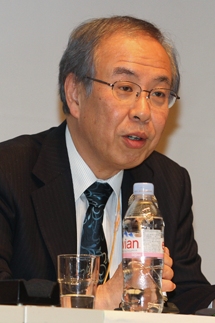 Mr. Toshiro Mochiji
Mr. Toshiro MochijiToshiro Mochiji
In the presentation titled "The Fukushima Daiichi Nuclear Accident: Lessons and Responses", Mr. Mochiji told the panel about the impacts that the accident had on Japan's use of nuclear energy. His presentation included suggestions regarding recurrence prevention made at the Investigation Committee on the Accident at the Fukushima Nuclear Power Stations of Tokyo Electric Power Company (the governmental accident investigation committee), the new regulatory system after the Nuclear Regulation Authority was set up, a summary of new regulatory standards and how they had been developed, safety reviews, and lessons learned and responses regarding nuclear security. Then he stated that stricter nuclear non-proliferation and security, transparency of policies on the nuclear fuel cycle, and development of technologies for proliferation resistance must be priority to ensure nuclear non-proliferation and nuclear security.
Thomas Countryman
Mr. Countryman explained the impact that the accident at TEPCO's Fukushima Daiichi Nuclear Power Station had had on a global scale, the US government's policy on nuclear security, and expectation for Japan.
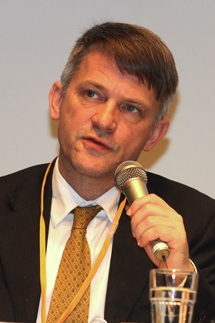 Mr. Thomas Countryman
Mr. Thomas Countryman- The Accident at TEPCO's Fukushima Daiichi Nuclear Station directed international attention to the programs for peaceful uses of nuclear energy in general, and the risks inherent in peaceful uses of nuclear energy. These risks include not only those posed to nuclear safety, but those to nuclear security and non-proliferation.
- Since the 2010 NPT Review Conference, the United States has worked to raise international awareness of how beneficial peaceful uses of nuclear energy with no CO2 emissions can be, to build trust in the safety and security of nuclear power generation, and to help enhance other countries' capabilities to enhance nuclear non-proliferation and nuclear security.
- The three-and-a-half-year process of the nuclear security summit has successfully directed international attention to nuclear security, prompting all nations with nuclear infrastructure to acknowledge nuclear terrorism as a genuine threat and to improve their own nuclear security. The multilateral commitment called "gift baskets" will dramatically improve nuclear security as a whole. Activities within the framework of the Global Initiative to Combat Nuclear Terrorism are also ongoing.
- After the NPT Review Conference and the Nuclear Security Summit in 2010 and the TEPCO's Fukushima Daiichi Nuclear Accident in 2011, many countries began to implement INFCIRC225/Rev5, and received the IAEA International Physical Protection Advisory Service (IPPAS). Nuclear security has obviously been enhanced from a global perspective.
- The world is paying attention to Japan's energy policy and nuclear fuel cycle policy. Japan has depended on nonnuclear fuels since the accident, which has already had an impact on international energy markets. If Japan maintains its policy to phase out the nuclear power generation, the competitiveness of Japan's nuclear industry in overseas markets can be damaged, and the effect can reach the United States, as it cooperates with Japan in nuclear business.
- No matter what decision Japan makes in connection with its nuclear energy policy, responsibility to provide nuclear security will never go away.
- Japan has improved its nuclear security in recent years, so we must say that the country is on the right track. It is said that the so-called safety myth eventually led to the nuclear catastrophe in Fukushima. Japan must be careful not to assume that there is no nuclear security threat in the country just because it is located far away from the United States or the Middle East, and because its people are so homogeneous; that is, "the nuclear security myth" must be avoided. Nuclear material attracts terrorists, no matter which country it comes from. Japan should continue to improve its security systems, and this includes considering adopting trustworthiness check.
- Wherever weapon-usable nuclear material exist, risks cannot be eliminated completely, no matter what kinds of safeguards or nuclear security systems are applied. For this reason, the United States has opposed the proliferation of uranium enrichment and reprocessing, and provided alternative means so that other countries have no need to do the enrichment and reprocessing on their own. The United States, Japan and the IAEA have cooperated in developing safeguards technologies as well as physical protection technologies. The cooperative efforts have helped reduce risks that can arise from nuclear material in Japan.
Robert Einhorn
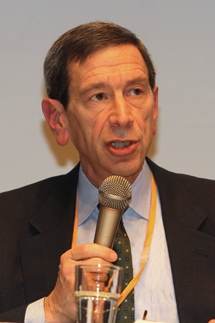 Mr. Robert Einhorn
Mr. Robert Einhorn- On November 24, P5+1 and Iran reached an interim agreement, which is significant progress. While this is a historic step, whether they can reach a final agreement within six months from the date the interim agreement was made remains an issue. The second priority is the denuclearization of North Korea. The United States requires that North Korea agree to the goal of "complete and verifiable denuclearization" if it wishes to hold negotiations with the United States.
- The third priority is to address the security concern of nations that might take an interest in owning nuclear weapons in response to nuclear development by Iran and North Korea. These countries include the United States' allies and partners, such as Saudi Arabia, Egypt, and Turkey in the Middle East, and Japan and South Korea in Asia. There is a mistaken impression that the United States has become less involved in addressing overseas nuclear issues, but the United States will demonstrate that such impression is erroneous in the weeks or months to come.
Each country has made major progress in its domestic system for export control. Japan in particular has been playing a leading role in strengthening export control that developing countries can learn from. With regard to the prevention of further proliferation of uranium enrichment and reprocessing technologies and plants, there should be as little incentive as possible for a nation to have its own nuclear fuel cycle capabilities. Friction between nuclear-weapon States and non-nuclear-weapon States — particularly non-aligned movement states — has made it difficult to strengthen the NPT. Both nuclear-weapon States and non-nuclear weapon States must implement the efforts toward nuclear disarmament and nuclear non-proliferation required by the NPT. While the United States is ready to reduce its nuclear weapons beyond the level agreed in the New START, Russia resists a reduction to that level. Also, making the Additional Protocol universal and imposing sanctions against noncompliant countries are vital to nuclear non-proliferation. The Nuclear Security Summit to be held in The Hague next year will set the stage for a further strengthening of nuclear security.
Christophe Xerri
- As a country with large-scale nuclear energy program, Japan has strong international credential when it comes to nuclear non-proliferation, so it should play a prominent role in nuclear non-proliferation and nuclear security. With regard to nuclear security, Japan needs to do more especially against internal threats. Besides, when it exports nuclear material and equipment to countries that have decided to adopt nuclear power generation, Japan should urge the recipient states to take measures necessary for nuclear security and non-proliferation.
Davis Hurt
- The Accident at TEPCO's Fukushima Daiichi Nuclear Power Station had a major implications on nuclear non-proliferation, and the application of safeguards in particular. After the accident, the IAEA faced a situation in which it could apply no normal safeguards approach or method because the rising radiation level blocked the IAEA inspectors' access to the plant, and safeguards equipment had been damaged. So the inspectors had to turn to special methods and extraordinary types of access. We have to emphasize that the Japanese government and businesses were extremely cooperative in continuing effective safeguards in Fukushima. They provided us with far more information than the safeguards agreement requires.
Hajimu Yamana
- Japan is in a special position in that, although it is a state with large-scale nuclear energy program, it has chosen not to own nuclear weapons. It has delivered clear messages about nuclear non-proliferation to the world, and, especially in terms of safeguards, taken the lead in ratifying the Additional Protocol and applying integrated safeguards. I believe that these efforts can serve as a model for other nations committed to peaceful uses of nuclear energy, and that Japan should maintain and enhance this so-called "Japan Model." If the concept of the multilateral control of nuclear material will be materialized to strengthen nuclear non-proliferation, Japan should promote the system as part of its efforts.
- Japan has adopted INFCIRC225/Rev5 as part of its enhanced efforts toward nuclear security in recent years. Since the Accident at TEPCO's Fukushima Daiichi Nuclear Power Station , there has been even greater need for enhanced nuclear security, prompting the country to strengthen the security in tandem with enhancement of nuclear safety.
- As a member of the NSG, it is a given that Japan strictly deals with any leakage of information or technologies.
- As a country that let the accident occur, Japan is responsible for pursuing world-class safety and safety culture.
- Japan has participated in the development of safeguards technologies by the IAEA and others, and it boasts world-class technologies applicable to nuclear security, such as measuring and monitoring techniques, electronics, and information technology. By sharing these safeguards and nuclear security technologies with the international community, Japan is capable of contributing to nuclear non-proliferation.
[Discussion Point 2: Challenges and necessary measures for ensuring nuclear non-proliferation and nuclear security of fuel cycle options]
Toshiro Mochiji
As the starting point, Mr. Mochiji introduced the discussions about nuclear non-proliferation and nuclear security in connection with options for the nuclear fuel cycle held at the Technical Subcommittee on Nuclear Power, Nuclear Fuel Cycle, etc. under the Atomic Energy Commission.
- The subcommittee presented the view that the once-through fuel cycle poses the lowest risk of nuclear proliferation, and the risk grows higher in recycling of MOX, and grows further in recycling through fast reactor (FR)/fast breeder reactor (FBR), so advanced safeguards will be required. The issue involved in the use of FBR is that it separates plutonium containing high quantity of fissile material. Proliferation resistant technologies have been under development. The subcommittee, however, stated that experts are split on the effect of the technologies.
- The once-through fuel cycle also poses the lowest nuclear security risk. Spent fuel is inaccessible for nearly 100 years after it is disposed of in geological repository, so the risk is relatively low. MOX recycling and the use of FR/FBR, on the other hand, pose a higher risk of terrorism because of the use of separated plutonium and the necessity of plutonium inventory and of the frequent transportation of plutonium, requiring higher levels of security.
- Last year's International Forum dealt with this topic. The discussion pointed out that once-through cycle which poses low risks in the short-term, pose a long-term challenge of so-called plutonium mine in which radiation level will decrease a few centuries later, and thus needs to address such long-term risk for nuclear non-proliferation and nuclear security.
Nuclear Non-proliferation and Nuclear Security for Open Fuel Cycle
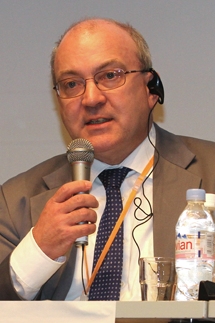 Mr. Davis Hurt
Mr. Davis HurtDavis Hurt
- There is not yet a spent fuel repository, so, at present, we can only speculate what kinds of safeguards we should apply to the repository. The IAEA has been discussing this issue with the member states for years, developing basic concepts.
- IAEA safeguards consider spent fuel repositories to be nuclear facilities, so full safeguards measures used for nuclear facilities will be applied to the repositories. Safeguards agreements and other documents that specify policies regarding IAEA safeguards do not include provisions that stipulate the termination of safeguards to spent fuel unlike radioactive wastes. This means that safeguards apply indefinitely.
- The basic concept of the indefinite application is that a repository to be developed is closely reviewed through the design information verification, the repository is validated when spend fuel is brought in, and the validation is regularly conducted throughout the time that the repository is accessible. After the repository becomes inaccessible after its closure, measures to keep the surrounding area of repository under surveillance should be implemented so that any excavation can be detected.
Christophe Xerri
- Repositories do not pose any safety issues. It is possible to ensure the safety of the repositories for centuries.
- Records of technical information, such as the whereabouts of spent fuel, can be kept for five hundred years.
- Safeguards are supposed to continue indefinitely, so, as technologies advance, any activity on repositories can be detected. Society demands that reversibility be ensured, however reversibility makes it difficult to apply safeguards.
- In terms of nuclear security, retrieving spent fuel is no easy task. However, things might be different several hundred years later, even in regions politically stable today.
- As can be seen, direct disposal of spent fuel involves difficulties. It is more desirable to take the safe approach for which we already have technologies, that is, recycling plutonium. We expect that future technological development will create a better technique for the disposition of plutonium.
Nuclear Non-proliferation and Nuclear Security for Closed Fuel Cycle
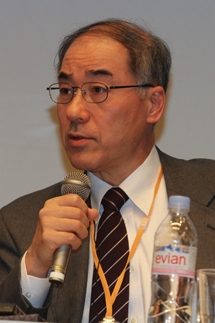 Prof. Hajimu Yamana
Prof. Hajimu YamanaHajimu Yamana
In the presentation titled "Prospects for fuel cycle issues in Japan," Mr. Yamana explained the significance of the closed fuel cycle for Japan, the present situation and challenges for nuclear fuel cycle in Japan, challenges associated with safeguards and nuclear security.
- Discussions that include the nuclear energy policy have been ongoing at the Advisory Committee for Natural Resources and Energy. Ten issues about nuclear energy are under discussion, and two of them are about the back end of nuclear fuel cycle. The Japanese public increasingly opposes nuclear power generation for three major reasons: lack of safety, lack of reliability, and the unresolved back end of nuclear fuel cycle. Therefore, it is vital to solve these problems.
- The closed fuel cycle is designed to recycle spent fuel, which makes nuclear energy more sustainable. Japan has chosen the closed cycle to use natural resources efficiently and to optimize waste disposal. Depending on their circumstances, some countries use the open fuel cycle that treats spent fuel as waste.
- The Technical Subcommittee on Nuclear Power, Nuclear Fuel Cycle, etc. compared the two options for the fuel cycle, and concluded that the closed fuel cycle offers advantages in terms of the efficient use of natural resources, reasonable waste disposal, and the flexibility for future technology choice, that the closed fuel cycle has disadvantages in economic competitiveness, and that, although the two options do not differ significantly in safety, the closed fuel cycle requires more advanced safeguards and physical protection . Based on these conclusions, a recommendation has been made that the decision to use the Rokkasho Reprocessing Plant should be maintained and how to treat spent fuel after interim storage and spent MOX fuel should be determined in the future.
- According to the estimate I made myself, there would be at least 40,000 tons of spent fuel in 2040 if all nuclear reactors in Japan were shut down after 40 years of operation, and spent fuel can be reduced if it is reprocessed at Rokkasho Reprocessing Plant. In that case, however, the number of light water reactors that burn plutonium will decrease gradually, generating surplus plutonium. Therefore, this scenario may be problematic. If nuclear reactors operated for 40 years or longer, there would be even more spent fuel.
- Japan's nuclear fuel cycle involves many different issues, including ones about technologies, material control, policies and regulations, lost public confidence, and costs. Technical problems have caused delay in the operation of the Rokkasho Reprocessing Plant and in the further development of fast breeder reactors. Consequently, Japan's nuclear technologies have lost the trust of the public and the government.
- The closed fuel cycle requires advanced safeguards. Large Scale Reprocessing Plant Safeguards explored safeguards to apply to the Rokkasho Reprocessing Plant. Based on conclusions of this project, the near real time accountancy (NRTA) has been adopted, a laboratory called OSL has been set up, and solution monitoring technologies have been developed. I believe that, with these measures, there should be no problem in applying safeguards to the Rokkasho Reprocessing Plant. As for nuclear security, there should be stronger defense in depth against human actions.
- Japan should internationally demonstrate the applicability of safeguards to large-scale reprocessing facilities by operating the Rokkasho Reprocessing Plant, and consume 35 tons of plutonium from overseas in light-water reactors as soon as possible.
The Agreement for Cooperation between the Government of Japan and the Government of America Concerning Peaceful Uses of Nuclear Energy, which took effect in 1988, granted Japan programmatic advance consent of the United States to reprocessing. From 2018 onward, the Agreement can be terminated on notice by either country. - As the president of the International Research Institute for Nuclear Decommissioning, I must add that it is vital to ensure the application of safeguards and nuclear security on the site of the Fukushima Daiichi Nuclear Power Station.
Mochiji
- The closed fuel cycle has lower proliferation resistance than the open fuel cycle in the short term, but it has so far been addressed by means of IAEA safeguards and reinforced physical protection of nuclear material. It is necessary to maintain the same level of diligence after the activation of the Rokkasho Reprocessing Plant in the future.
- In terms of long-term implications, the closed fuel cycle has the advantage of termination of safeguard with vitrified waste. The open fuel cycle, on the other hand, requires indefinite safeguard measures after the disposal, which calls for further discussion. Plutonium mines will be potential risks. Also, considering the need for ensuring retrievability, nuclear proliferation risk is not necessarily low for the open fuel cycle.
- The closed fuel cycle is more promising in terms of non-proliferation and nuclear security, as it does not increase the gross amount of plutonium if the fast reactor cycle stabilizes.
Hurt
- The closed fuel cycle involves reprocessing and MOX fuel fabrication, which poses a significant issue of how to apply safeguards to such a large-scale facility dealing with a large amount of plutonium. It is difficult to measure plutonium and no measuring equipment can be free from measurement errors, and small errors may amount to a significant level of uncertainty. However, whereas the application of safeguards to spent fuel repositories is still a virtual problem the IAEA has experience in applying safeguards on the closed fuel cycle. It has been successful at the Tokai and Rokkasho Reprocessing Plants. The IAEA maintains a policy to make safeguards as strict as possible concerning plutonium. If an accident happens in plutonium-handling facilities, which we certainly hope not, the situation is expected to be far more seriousthan Fukushima's case in terms of safeguards.
Xerri
- Japan, France, the United States, and South Korea may contribute to the IAEA's development of plutonium measuring technology. France does not want to have reprocessing facilities spread out globally. It is more desirable to have a limited number of large-scale reprocessing plants in terms of safeguards and nuclear security. There is a question of whether the society takes the direction to reduce plutonium volume or lower the grade. In case of reaching a consensus as such, contributions to non-proliferation can be made through deploying fast reactors for burning plutonium.
- The French policies are aligned with social demands, and they take into account the reuse of scarce energy resources and reduction of waste in an effort to minimize the environmental impact. Consequently, France has chosen to adopt the closed fuel cycle, and is undertaking reprocessing based on the principle of non-proliferation, maintaining plutonium inventories at a certain level.
Significance of Closed Cycle
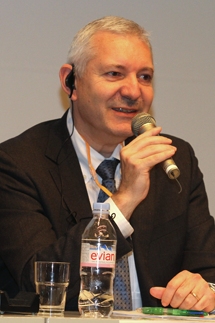 Mr. Christophe Xerri
Mr. Christophe XerriXerri
He explained French nuclear fuel cycle policy:
- There are 58 nuclear reactors currently in operation, with an additional European Pressurized Water Reactor(EPR) under construction. Of these, 22 utilize MOX fuels, with a maximum of 25-percent reduction on the use of natural plutonium. EPR can also run on 100 percent MOX fuels.
- The selection of a final repository site is also in progress, and we have obtained support from local residents of the target areas after talks. The site is expected to go into operation between 2015 and 2020.
- In order to avoid growing plutonium inventories, we are reprocessing spent fuel taking into account the amount of plutonium consumable by 22 reactors, and in theory, it is possible to reprocess more. Although spent MOX fuel can be technologically reprocessed, reprocessing is not being conducted at present. From a long-term perspective, France is advancing the development of fast reactors, which recycle plutonium more efficiently. There is a plan being developed for a demonstration reactor known as ASTRID, and it is currently in the design stage. We expect that a decision will be reached by 2019 as to whether the construction will actually take place. It is hoped from the perspective of international cooperation that the Monju and Joyo will resume operations.
Hurt
- Considering that the IAEA every year reaches the conclusion that there is no indication of diversion of plutonium, the safeguards applied at plants handling plutonium are presently sufficient. However, it must be taken into consideration that the Tokai Reprocessing Plant is of relatively small scale and the Rokkasho Reprocessing Plant has only experienced a short-term safeguards implementation. In Europe, EURATOM has its safeguards in place for large-scale plants in Britain and France, and I believe they conclude that there is no indication of plutonium diversion. Large-scale plutonium processing plants deal with nuclear material ten times more than small-scale counterparts, and the IAEA may be pressed to the limit of being able to draw firm conclusion. A significant amount of investment has been poured into developing measurement technologies. The governments of Japan and other states are aware of the necessity to continue such investments in the future in order to ensure successful application of safeguards to large-scale plants.
Einhorn
- While Japan and France have chosen the closed fuel cycle, the United States and many other developed countries, which once opted for the same, have changed their policies to adopt other methods. If the closed fuel cycle has advantages in terms of efficient use of resources and economic competitiveness and waste disposal, a question arises as to why these countries have abandoned this option.
Xerri
- There are two issues in this point: whether these countries would build a reprocessing plant in their own countries, and whether they would accept the policy of reprocessing. For example, Germany and Belgium abandoned the idea of having nuclear reprocessing facilities within their territories, but they entrusted the task to Britain and France. In the case of Sweden, they abandoned the reprocessing when it decided to phase out nuclear power.
- Meanwhile, France and Japan already possess established reprocessing plants. Considering they do not have energy resources, there is no reason for them to abandon reprocessing itself. All countries, except Sweden and Finland, have not made decisions on the repositories for spent nuclear fuel. A lot of states keep future options open while storing spent fuel, so that there are possibilities that they may have recourse to reprocessing if direct disposal proves unsuccessful.
Einhorn
- The advantages in the closed fuel cycle, particularly on the point of nuclear waste disposal, are attainable only when fast reactors are deployed. However, fast reactors have not yet been available for commercialization, and it is not clear how long it is going to take before commercialization becomes a reality. Can interim storage not be a tentative solution so that the final decision may be postponed in such circumstances where both the commercialization of fast reactors and the final disposal of spent fuel involve uncertainties?
Xerri
- Interim storage is an attractive solution for many countries that are yet to come to their decisions. On the other hand, those countries that already possess programs for reprocessing or fast reactors need to continue their efforts in research and development for the future, including the enhancement of proliferation resistance.
Einhorn
- France possesses reactors, many of which are adaptable to MOX fuel use, however, interim storage may be a viable option for countries such as Japan, where supply and demand for plutonium are out of balance. With a limited number of reactors that can burn MOX fuel, the operation of the Rokkasho Reprocessing Plant would increase the imbalance.
Yamana
- There are 35 tons of plutonium overseas that needs recycling first. The Rokkasho Reprocessing Plant will operate bearing this in mind and in line with the consumption of plutonium, rather than processing 800 tons of uranium a year. Therefore, the plutonium balance will be kept under control. It is more important to address the delay in the restart of the operation of light water reactors due to the safety review. Also from political and social perspectives, the consent on deploying MOX fuels must be secured from the local population. If we abandon the Rokkasho Reprocessing Plant, Japan will need more interim storage facilities. However, it will give rise to a social issue of whether the country could construct storage facilities in unlimited numbers. It will be necessary to strike a balance between the Rokkasho Reprocessing Plant operational mode, MOX fuel utilization in light water reactors, and the interim storage capacity.
Nuclear Security
Mochiji
- Toward the Nuclear Security Summit next year, Japan needs to address the issue of trustworthiness check against internal threat. Nuclear security in transportation will be a challenge not only for Japan but also for other countries. Minimizing the use of highly enriched uranium is a world trend today, and Japan has been contributing to the international community by returning a considerable part of the uranium under JAEA's possession to the United States.
Yamana
- It is important to avoid the "nuclear security myth." To be more precise, it is important to consider every possibility of risk in terms of the design basis threats (DBT) and formulate countermeasures in both hardware and software approaches. It is necessary to cultivate the ethics of diligence at each nuclear power plant in Japan to incorporate DBT analyses into their preparation of necessary measures.
Xerri
- Responses in both hardware and software aspects are important. Situations vary from country to country. A successful case in one country may not necessarily be applicable in another. Therefore, each country needs to prepare and implement regulations and measures in accordance with its own particular situation. The purpose of the Nuclear Security Summit is to raise international awareness of the importance of nuclear security. France will continue to be committed to the gift basket concerning the transportation security as a member country to the gift basket.
Endo
- It is my personal view that the level of awareness of the nuclear security issues is low in Japan. For instance, Japan ranks low, almost the lowest, in the Nuclear Threat Initiative (NTI) Index. Japan should be aware of the international perception and improve its nuclear security status.
Distinction of Safeguards Application in accordance with the Isotopic Ratio of Plutonium
Endo
- Does the nuclear proliferation resistance vary for plutonium in different forms (liquid, powder, and pellets)?
Hurt
- I would like to talk about the safeguards applicable to respective options in plutonium management. The plutonium under safeguards is mostly in the form of spent fuel, and it is increasing rapidly in quantity. It is therefore no exaggeration to say that future nuclear non-proliferation largely depends on the safeguards applied to spent fuel. Because the spent fuel stored in spent fuel pools can be visually observed, implementing safeguards on plutonium in this state would be the simplest and least costly way. The second alternative is to apply safeguards to spent fuel in dry storage, which is widely practiced in Europe and Canada. The safeguards applicable to spent fuel at repositories are still only conceptual, and the safeguards regarding plutonium in the closed fuel cycle have only been applied to a small-scale facility so far. However, there has been no major discrepancy in the plutonium inventory, which suggests successful implementation.
Mochiji
- There is no differentiation in the safeguards between reactor-grade plutonium and weapon-grade plutonium in terms of its treatment. My personal view is that, from the perspective of attractiveness, plutonium should be treated differently based on the fissile plutonium content ratio. I also think that the level of attractiveness to terrorists may differ in terms of the forms of plutonium and whether plutonium exists as a simple substance or as MOX.
Yamana
- The success of plutonium management in the foreseeable future depends on whether the safeguards will maintain a high level of sophistication. It seems possible by deploying methods such as NRTA, which is employed at the Rokkasho Reprocessing Plant. It is important to evaluate the validity of this method in cooperation with the IAEA.
- From a long-term perspective, there is a question about international plutonium management, although it depends on the extent to which nuclear power will be relied on. Options may include that plutonium should be used to exhaustion in anticipation of the end of the nuclear-dependent era, on the one hand, and, supposing the perpetual use of nuclear reactors, plutonium should be reserved to utilize it as a resource while ensuring retrievability, or used as MOX fuels in light-water reactors as a temporary measure. The latter seems preferable, but there must be international discussions on this.
Xerri
- So far, the safeguards on plutonium have been successful. Additional Protocol provide for the detection of undeclared nuclear activities.
[Floor Questions and Answers]
Question 1
- Studying the cases from the countries that successfully developed nuclear weapons, it seems not too difficult to separate plutonium, but the Rokkasho Reprocessing Plant has trouble succeeding in this. Is there a difference in the plutonium separation process between reactor-grade plutonium and weapon-grade plutonium? Supposing that Iran attempts to separate plutonium from the spent fuel produced in heavy water reactors, would they employ similar technology to the Rokkasho Reprocessing Plant?
Xerri
- The problem that the Rokkasho Reprocessing Plant faces is not the separation of plutonium but vitrification. The technologies are not very different from one another. Generally speaking, reprocessing is easier to perform on a small scale than on a large scale.
Question 2
- There seems to be a discrepancy in terms of the NPT concerning nuclear cooperation with India. Shouldn't this be resolved before any other issues are considered?
Einhorn
- Under the previous administration, the United States decided to cooperate with India for the peaceful use of nuclear energy, and thus persuaded other states to agree to grant an exception to the NSG guidelines, which does not allow nuclear cooperation with countries without comprehensive safeguards agreement in place. I was against the US-India civil nuclear agreement, and testified against it in Congress. The Obama administration has maintained this policy, in anticipation of bringing India closer to the non-proliferation mainstream, which has been partially successful as, for example, India strengthens its export control. Nonetheless, it cannot be denied that the exceptional treatment is problematic in the sense that it sends out a wrong message, portraying the rules as being easily bent, and also that it constitutes a double standard comparing with the treatment of countries such as Pakistan and Israel.
Question 3
- On weapon-grade and reactor-grade plutonium, it was reported in the media that plutonium can be utilized to make weapons even if it was burnt up in reactors to some extent. How far has discussion made on the introduction of distinction of safeguards based on the fissile plutonium content ratio?
Hurt
- IAEA safeguards treat all kinds of plutonium equally, with the exception of pure plutonium 238. This is because the IAEA lacks the ability to sufficiently evaluate the attractiveness of plutonium diversion in terms of the isotope ratio due to the absence of information within IAEA regarding plutonium utilized in nuclear weapons.
Einhorn
- If the recent media reports were true, that a nuclear test had been conducted using reactor-grade plutonium in the past, treatment of plutonium must be handled very carefully regardless of the isotopic composition.
Question 4
- What is the reason for the poor rating of Japan in the NTI assessment regarding nuclear security?
Endo
- The reasons include the large quantity of plutonium under possession, many storage facilities, frequent transportation of plutonium, a lack of sufficient separation between promotional role and regulatory role of nuclear energy use, absence of armed guards for physical protection of nuclear material, and a lack of measures against internal threats. This is, after all, a reflection by one think tank.
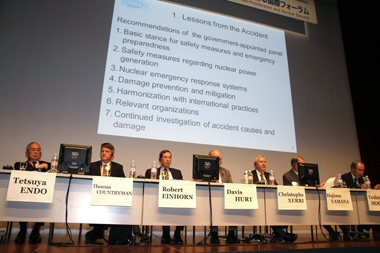
Panel Discussion 2
"Roles of safeguards and technical measures for ensuring nuclear non-proliferation for nuclear fuel cycle options"
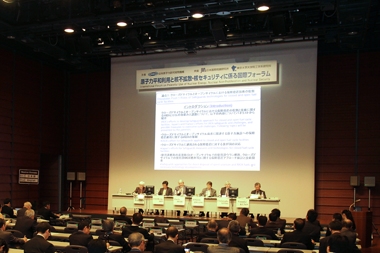
- Chairperson
- Prof. Satoru Tanaka, Department of Nuclear Engineering and Management, School of Engineering, The University of Tokyo
- Panelists
- Prof. Joonhong Ahn, Professor and Vice Chair, Department of Nuclear Engineering, University of California, Berkeley
- Mr. Davis Hurt, Head of the IAEA Tokyo Regional Office
- Prof. Il Soon Hwang, Department of Nuclear Engineering, School of Energy Systems Engineering, Seoul National University, Republic of Korea
- Mr. Christophe Xerri, Nuclear Counsellor at the Embassy of France in Japan
- Dr. Yusuke Kuno, Deputy Director, Department of Science and Technology for Nuclear Material Management (STNM), JAEA
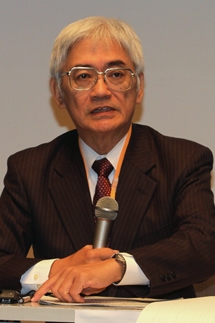 Prof. Satoru Tanaka
Prof. Satoru TanakaDiscussion points
- Roles of Safeguards technologies for closed and open fuel cycle facilities
- Efforts for improving proliferation resistance and developing technologies for plutonium burning as technical measures for enhancing nuclear non-proliferation
Summary of Panel Discussion
In this panel, the topic for discussion was the roles of safeguards, plutonium burning technologies, and other technical measures for proliferation resistance that are employed in ensuring non-proliferation and nuclear security of back end of nuclear fuel cycle.
The first speaker was Mr. Hurt, who explained the evolution of the IAEA safeguards and stated that the current safeguards were characterized by the notion of "State-Level Concept" as opposed to the previous safeguards that centered on verification of nuclear material. He pointed out that it was becoming more important today to assess state overall proliferation risks in countries where safeguards are applied, using diverse information. Dr. Kuno from JAEA explained the safeguard initiatives in Japan. He stated that various efforts were exerted to improve the safeguards technically at the Rokkasho Reprocessing Plant. He also emphasized that, more importantly, nuclear activities should be transparent, the significance of which could be recognized in the fact that "cooperation with the IAEA" was one of the assessment factors in the "State-Level Concept." He asserted that reliability of safeguards for large-scale facilities would improve through maintaining close communication with the IAEA. Professor Hwang from the Seoul National University suggested that challenges lay in the implementation of safeguards on the pyroprocess, which is under development in the Republic of Korea. Professor Ahn from the University of California, Berkeley, pointed out the necessity to consider adjusting safeguards in accordance with the design of repositories because different safeguard measures may be required depending on some conditions at repositories, such as the depth and types of rock.
As a long-term challenge, Dr. Kuno raised the issue of the need for distinction of safeguards application in terms of plutonium isotopic ratio in the final wastes (spent fuel in the case of the open fuel cycle). In response to this, Mr. Hurt stated that an introduction of several plutonium grades into the safeguards mean that the IAEA had to verify the grade of declared plutonium, and that there was no advantage in pursuing this option in terms of efficiency for the time being.
Several panelists also suggested the value of support to emerging nuclear states for their efforts for accounting for and control of nuclear material by the IAEA and advanced nuclear states , and the value of introducing the concept of "safeguards by design(SBD)" for the export of nuclear equipment.
In relation to proliferation resistance nuclear technologies, Prof. Ahn described some technical options to improve the proliferation resistance, such as deep-burning of Pu-239 using TRISO type coated fuels in high-temperature gas-cooled reactors, while Prof. Hwang presented the partitioning and transmutation technology that enables conversion from high-level radioactive waste to intermediate-level waste, known as PyroGreen, and a vision for a regional nuclear fuel cycle scheme based on this technology. Mr. Xerri outlined France's fast reactor project, the ASTRID program. Prof. Ahn suggested that the overall nuclear material consumption including that of reprocessed and depleted uranium may be enhanced by combining the uranium burning (breeding of plutonium) with fast reactors and the plutonium burning with high-temperature gas-cooled reactors .
Regarding the relationship between proliferation resistance and safeguards, Mr. Hurt stated that the safeguards level could be lowered if the proliferation resistance was improved, but a complete removal of safeguards was impossible since no technology was immune from the risk of misuse.
Dr. Kuno commented that a long-term vision must be presented for the use/consumption of plutonium, which would include proliferation resistant nuclear technologies and international management, although the latter might prove difficult to realize.
[Discussion Point 1: Roles of Safeguards technologies for closed fuel cycle and open fuel cycle facilities]
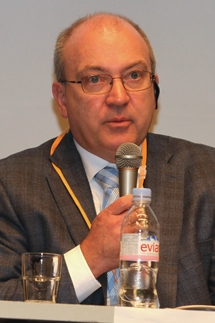 Mr. Davis Hurt
Mr. Davis HurtHurt
- History of the IAEA safeguards development could be divided into four major periods.. During the first ("classical") period from the establishment of the IAEA in the 1950s up to the 1980s, the main role for the IAEA was to verify nuclear material, engaging predominantly in verifying independently the credibility of reports submitted by member countries, and checking for discrepancies between reports provided by an exporting states and an importing state.
- The safeguards approach in this period was effective only so far as the countries in question declared the nuclear material in their possessions. This shortcoming of the safeguards became clear after the Gulf War when it was found that Iraq had engaged in undeclared nuclear program. This fueled debate for reinforcing the IAEA safeguards (the second period, called "strengthening" period), leading to the adoption of the model Additional Protocol.
- The third period was characterized by "integration", as the methods employed under the conventional safeguards and Additional Protocol were integrated and optimized for application.
- At present, we are entering the fourth period, which may be characterized by the introduction of the "State-Level Concept". This concept provides for adjustments to safeguards applications in accordance with the IAEA's nuclear proliferation risk assessment, aimed at specific states. One third of the IAEA resources for safeguards is allocated for Japan, and the Republic of Korea was second to Japan in 2011, but in 2012 it was Iraq instead of South Korea. Here, allocating more resources to the states with higher nuclear proliferation risks is a reflection of the main tenet of the "State-Level Concept". An efficient use of available resources is crucial, particularly when there are only 250 inspectors at the IAEA who engage in safeguards.
Xerri
- Although France is a nuclear-weapon State, which means the application of IAEA safeguards is limited, it is subject to EURATOM safeguards. The EURATOM safeguards are applicable to nuclear-weapon States - and non-nuclear-weapon States indiscriminately, targeting all civil nuclear programs. Therefore, the safeguards implemented in France by the EURATOM are equivalent to the IAEA safeguards. France provides support to safeguards of the IAEA and EURATOM through research in the areas of measurement technologies and others conducted by institutions such as the Alternative Energies and Atomic Energy Commission (CEA) and the Institution of Radiation Protection and Nuclear Safety (IRSN).
- The development of pyroprocessing technology, which is currently underway in France, also takes into account the concept of SBD3 as well as nuclear proliferation resistance.
3 Safeguards by design (SBD) is a concept that integration of safeguards in the design process of a new nuclear facility from the initial planning will enhance the ease of implementation of the safeguards.
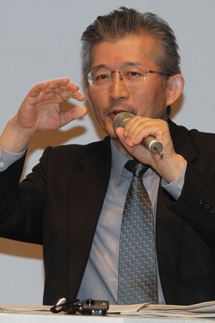 Dr. Yusuke Kuno
Dr. Yusuke KunoKuno
A presentation entitled "Measures against proliferation risk on closed/open fuel cycle" was given, which described safeguards initiatives in Japan and explained proliferation risks in relation to the closed and open fuel cycles.
- A range of measures has been taken at the Rokkasho Reprocessing Plant to implement safeguards. Even if there emerged material unaccounted for (MUF) in the future, it can be analyzed in cooperation with the IAEA. Therefore, there is no immediate implication forIAEA's safeguards conclusion for Japan.
- Although the closed fuel cycle involves a high risk of nuclear proliferation from a short-term perspective, burning plutonium in reactors will deteriorate its quality in terms of the attractiveness for the diversion for nuclear weapons and, thus from a long-term perspective, the proliferation risk will decrease. Direct disposal, on the other hand, has a low proliferation risk in the short term, but the risk increases with time, because radioactive decay of fission products will result in fissile plutonium growing to a greater proportion.
- Research has been conducted in the United States for the distinction of safeguards application to plutonium from the viewpoint of the attractiveness for weapon diversion.
- Japan has adopted a policy to deploy fast reactors for efficient use of energy, but options such as high-temperature gas-cooled reactors running on TRISO type coated fuels and plutonium burning technologies using rock fuels are still possibilities for the purpose of plutonium consumption.
Xerri
- It is important to provide emerging nuclear states with support to develop state system of accounting for and control of nuclear material and training personnel. Member states and the IAEA must work together to render support for those states and pass on the knowledge and experience in safeguards implementation so that those states will comply with the safeguards obligations.
Hwang
- The Korea Atomic Energy Research Institute (KAERI) engages in the development of pyroprocessing technologies as part of spent fuel recycling technologies, but they are faced with many challenges in terms of developing safeguards technologies. While the pyroprocessing has many advantages in terms of proliferation resistance, applicability to fast reactors, and criticality safety as well as economic competitiveness, the challenges concerning safeguards are hindering its practical application.
- Regarding the safeguards for large-scale aqueous reprocessing facilities, they are sufficient at present so long as such facilities are contained within advanced nuclear states, where the proliferation risk is low. However, further improvements are necessary for the safeguards in case such facilities are to be exported to other states.
- Interest in introducing nuclear power generation is still high, particularly in emerging nations, even after the Accident at TEPCO's Fukushima Daiichi Nuclear Power Station. The Republic of Korea learned so much from the United States, France, Canada and other leading nuclear states at the time of introducing a nuclear power generation in the 1970s. It is now repaying the debt by providing support for other states, helping them with their introduction efforts. One example is that the Government of the Republic of Korea founded the Korea International Nuclear Graduate School (KINGS), which prepared a 19-item manual based on the IAEA documents4, which identified the milestones in the development of a nuclear power generation system, together with Korea's experience, to convey to the emerging nations. Through the communications with these emerging states, South Korea is passing on the message that they must dedicate their use of nuclear power to peaceful purposes and not engage in fuel cycle activities.
4 Milestones in the Development of a National Infrastructure for Nuclear Power, IAEA Nuclear Energy Series, No. NG-G 3.1.
Hurt
- The IAEA possesses capacity-building support programs for emerging nuclear states in the fields including safeguards. As to the safeguards fields, the IAEA is providing support in training. For example, recent close consultation on safeguards with Vietnam is yielding fruit in strengthening safeguards, as Vietnam signed the Additional Protocol and improved its safeguards infrastructure.
- The IAEA will continue providing its utmost support for emerging nuclear states and will appreciate individual efforts by advanced nuclear states with necessary safeguards experiences such as Japan and South Korea.
Xerri
- EURATOM also possesses various support programs on safeguards and other nuclear-related issues.
Kuno
- I suspect that the SBD concept has not been adopted by all the exporting states and suppliers of nuclear material and equipment. We must ensure that the exporters who have incorporated the SBD willnot lose the international market because of its cost disadvantage. Therefore, an international consensus must be obtained regarding SBD at the initiative of the IAEA.
Kuno
- Various measures have been considered to improve the accuracy of safeguards but improving transparency is more important. The State-Level Concept includes cooperation with the IAEA as one of the factors in its state assessment. For example, active communication through such means as the provision of additional information, including the operational data of the plant, to the extent possible, will increase the confidence on the safeguards applied to large-scale reprocessing plant.
Ahn
- Research on safeguards and concepts of nuclear security at the university level began after the 2001 terrorist attack in the United States, and it is still in its early stage. It is important to cooperate with the IAEA as well as with research institutes in other countries.
- The university faces a dilemma in terms of principles of disclosure and a need for transparency.
- SBD is very interesting as a university research theme.
Xerri
- The wider adoption of the concept of SBD is a long-term challenge. As a short-term solution, it is necessary to continue improving effectiveness and efficiency of safeguards by means of presently available technologies.
Kuno
- One might be concerned that the present institutional safeguards approach at a state level may be valid as safeguards in a super distant future, after tens of thousands of years, to deal with direct disposal. We must make a choice between the two options, taking these into account, and select the one that is least attractive from the viewpoints of nuclear proliferation and nuclear terrorism.
Ahn
- As Dr. Kuno stated, direct disposal of spent fuel undoubtedly poses a complex safeguard problem in the super-long term. It is more difficult to resolve than radioactive safety, which improves with time.
- Moreover, there are diverse options in direct disposal of spent fuel, possibly diversifying the appropriate implementation of safeguards, depending on factors such as the depth and the rock type of repositories. For example, disposal in deep boreholes5 makes it very difficult to retrieve the waste in the long term. If the repository is built in clay ground, post-closure detection will be more difficult than if it was built in a hard rock, as noises for excavation will be absorbed into clay.
- It is necessary to give consideration to safeguards technology options before implementing deep geological disposal.
5 The deep borehole is a concept that nuclear waste is disposed of at a depth of 2,000 to 5,000 m below ground level to ensure isolation from human environments.
Hurt
- Conventional safeguards of the IAEA were based on the concept of access to nuclear material. Spent fuel repositories sever access to the waste inside once they are closed, whereby it is important to verify the absence of attempts of non-declared access. Therefore, there needs to be an approach different from those of conventional safeguards.
Hurt
- There is a long-standing debate on introducing a distinction of safeguards by isotopic ratio in plutonium. There is no argument about the fact that the level of difficulty in diverting plutonium into nuclear weapons varies depending on the type of plutonium, and that plutonium nuclear weapon States use for the manufacture of nuclear weapons is significantly different from reactor-grade plutonium. The reason why the IAEA has not introduced distinction by plutonium isotopic ratio into safeguards is that there is no advantage in efficiency envisaged in practical application. Delineation of plutonium types will also pose a problem. If it is to be divided into grades A and B. The IAEA will have to verify the grade of plutonium that is declared by the states in question.
- It may be possible in the future that safeguard classification is introduced to differentiate a case of spent fuel after deep burning in high-temperature gas-cooled reactors, where fissile plutonium is almost nonexistent.
Kuno
- I am not suggesting for an immediate introduction of the plutonium disstinction. The question is about the feasibility of the current state of safeguards, which apply to reactor-grade plutonium contained in spent fuel, from a long-term perspective that encompasses the time when the utilization of nuclear energy comes to an end.
Xerri
- It may be a possible option to make a linkage between the introduction of the State-Level Concept and plutonium distinction.
[Discussion Point 2: Efforts for improving proliferation resistance and developing technologies for plutonium burning as technical measures for enhancing nuclear non-proliferation]
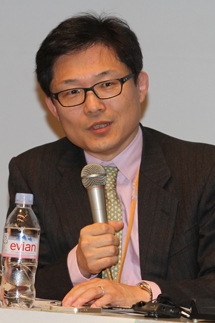 Prof. Joonhong Ahn
Prof. Joonhong AhnAhn
In a presentation entitled "Improvement of Long-term Proliferation Resistance," several technological options (waste treatment by plutonium burning with high-temperature gas-cooled reactors and fast reactors, disposal in deep boreholes) to improve proliferation resistance were explained.
- High-temperature gas-cooled reactors are suited for burning Pu-239, and can potentially achieve burning up to 90 percent of Pu-239 depending on the design. Therefore, there is a possibility of terminating safeguards application depending on the fuel composition.
- There are characteristics worth considering, other than the proliferation resistance, such as internal safety and fuel integrity in case of geological disposal, making it an attractive option for the future.
- Sodium-cooled fast reactors (SFR) will, if deployed as breeder reactors, increase short-term proliferation risks in terms of increasing plutonium stockpiles and interest in breeder reactors in other states.
- Both high-temperature gas-cooled reactors and sodium-cooled fast reactors are suited for destroying plutonium, neptunium, and americium. While the high-temperature gas-cooled reactors are capable of transmuting rapidly, deeply, but incompletely, , SFRs burn slowly, lightly, but completely. It is important to utilize both of them in order to maximize the proliferation resistance.
- The Accelerator-driven System (ADS), with two cycles: Pu and MA cycles for the primary and secondary, respectively, is an option with long-term merit.
- Deep borehole disposal has an advantage in that retrieval of waste is almost impossible, but there are challenges in terms of criticality safety and radiological safety issues due to the uncertainty involved in the deep underground environment.
- Many factors, including long-/short-term and international/domestic factors, must be taken into consideration when deciding on the fuel cycle to employ.
- An international fuel cycle system is indispensable to reduce the long-term proliferation risk.
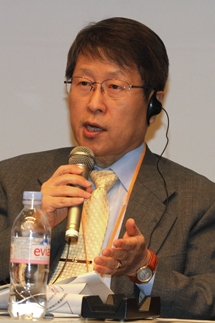 Prof. Il Soon Hwang
Prof. Il Soon HwangHwang
A presentation was given under the title "Closing Nuclear Fuel Cycle by Multinational Approach," explaining a multilateral approach to improve proliferation resistance in the closed fuel cycle.
- An advanced partitioning/transmutation technology for treating minor actinide and other fissile byproducts makes it possible to bring the level of waste category from high to intermediate or low. The US Waste Isolation Pilot Plant (WIPP) has demonstrated the intermediate level radioactive waste treatment, and there is merit in changing the categories.
- The US Academy of Science concluded in 1999 against the possibility of eliminating high-level radioactive waste using innovative partitioning/transmutation technologies. Ten years later, however, J. Leidler at Argonne National Laboratory (ANL) demonstrated that high-level radioactive waste was turned into low-level radioactive waste using the UREX+ technology.
- I have been running the Nuclear Transmutation Energy Research Center of Korea for the last 15 years. We are developing a process called PyroGreen for the purpose of waste decontamination, in cooperation with KAERI and ANL in US as well as with Japan and the EU. The research outcomes were reviewed by an independent specialist group in South Korea, and given an evaluation that the project was demonstrated at the laboratory level. This is a long-term development project, aiming to achieve commercialization in 2050.
- In the initial phase of research and development, aqueous process has more advantages than the pyroprocess from the viewpoint of proliferation resistance. As developing the pyroprocess become more advanced, we will move onto the second phase and deploy the pyroprocess.
- As much investment should be required for the development of these technologies , a regional approach is indispensable, in which Asian states come together, as they all share the issue of spent fuel management. Each state should pursue within their own territories the dry storage of spent fuel as a temporary measure while participating in long-term R&D. This will be valuable for raising awareness among the general public of sustainability of nuclear energy.
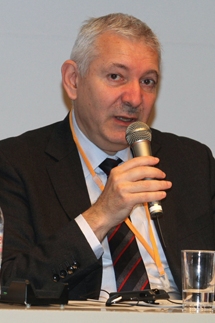 Mr. Christophe Xerri
Mr. Christophe XerriXerri
The ASTRID Project was explained.
- The fast reactor is a useful tool for non-proliferation, although they were not developed originally with this purpose in mind.
- The project is in its second phase of conceptual design, and detailed designing will commence in 2015. The major decision on actual construction is planned in 2019. Meanwhile, the project will be funded by the national government until 2019, provided that the project is pursued in accordance with the milestones. The commissioning of the plant is planned in 2025.
Kuno
- The approaches to plutonium consumption presented by the panelists are not immediately available for deployment. Japan will continue promoting the use of light-water reactors and Monju while keeping a long-term perspective open for innovative technologies for plutonium consumption.
Hurt
- The IAEA definitions of nuclear material do not include minor actinide (MA), and IAEA safeguards agreements does not require the application of safeguards to MA. It is so far a voluntary initiative that the states involved report their possession of neptunium and americium.
Xerri
- Although the feasibility of recycling, including of MA, has been verified, it is very costly. Whether MA recycling becomes a reality depends on the public acceptance of bearing the costs in the future.
Tanaka
- What can be said about the feasibility of consuming plutonium using high-temperature gas-cooled reactors?
Ahn
- Japan and many other countries have been engaging in R&D on high-temperature gas-cooled reactors already and gained results that positively suggest the possibility of their commercialization.. However, the development has been done in a different context such as s hydrogen production and high temperature heat source utilization. It needs reviewing in terms of plutonium burning. It may prove possible to relax some constraints for design.
- The accumulation of plutonium stockpiles should not pose practical problems, because safeguards are in place to monitor them. Therefore, the issue of stockpiling is seen more in the political context of international relations, particularly in terms of the Agreement for Cooperation between the Government of Japan and the Government of the United States of America, than in the context of safeguards. The technological development will require scheduling at pace with the actual needs for the technology.
Hwang
- Having regional fuel-recycling facilities with an increased capacity will improve economic competitiveness.
Kuno
- It is true that plutonium stockpiling will not pose a serious problem of diversion, because the safeguards are in place. At issue is that Japan has a policy not to retain any surplus plutonium, which may have some implications for the international perception of Japan. Japan needs to show a future vision regarding plutonium use. Such a vision should include something like the international management and development of proliferation resistance technologies.
Hurt
- There is no technology that is immune from misuse. Proliferation resistance is a matter of degree. Therefore, it is possible to lower the safeguards requirement levels as improvements are made on proliferation resistance, but not possible to remove the application of safeguards completely.
[Floor Questions and Answers]
Question 1
- How do you take into account future threats when considering to ensure proliferation resistance in a long-term?
Kuno
- Currently, our considerations are based on the present threats. It is necessary to take evolving threats into consideration.
Question 2
- The idea of deploying high-temperature gas-cooled reactors for plutonium burning is very interesting. Could you explain further on the point that fast reactors are necessary in addition to high-temperature gas-cooled reactors?
Ahn
- Supposing that the plutonium inventory management with a high-temperature gas-cooled reactor is under control, the major challenge that remains is how to dispose of reprocessed uranium and depleted uranium. If all the nuclear legacy must be cleaned up altogether at the end of the nuclear-dependent era, that should include uranium inventory. The high-temperature gas-cooled reactors cannot use the uranium-converted plutonium. For this purpose, it is reasonable to employ fast reactors. In this sense, a combination of fast reactors and high-temperature gas-cooled reactors would realize an efficient disposition method.
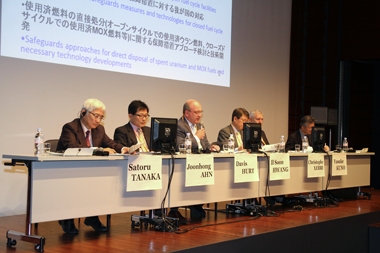
Closing Remarks
Mr. Tetsuya Endo, Ambassador, Adjunct Senior Fellow, The Japan Institute of International Affairs / Former Vice Chairman, Atomic Energy Commission of Japan
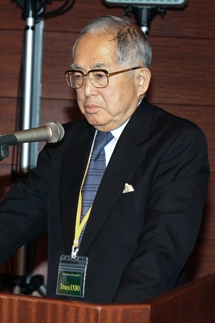 Mr. Tetsuya Endo
Mr. Tetsuya Endo- This Forum is unique in that three organizations with different characteristics come together to discuss policies and technologies. The forum is now becoming something of a regular feature, and we would like to continue our unchanged efforts in the future.
- The Agreement for Cooperation between the Government of Japan and the Government of the United States of America is the basis of Japan's conducting nuclear fuel cycle policy. I hope, as one who was involved in the agreement negotiations, that the agreement will extend beyond 2018.
- From this perspective, it is important to adhere to the policy of possessing no surplus plutonium and indicate a more concrete plan for plutonium usage.
Prof. Satoru Tanaka, Department of Nuclear Engineering and Management, School of Engineering, The University of Tokyo
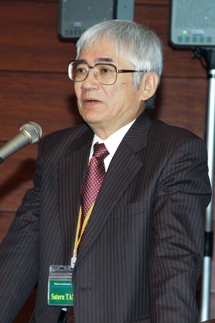 Prof. Satoru Tanaka
Prof. Satoru Tanaka- This forum is very unique in the sense that it contains elements of R&D, international politics, and human resource development in good measure. We need firm measures in non-proliferation and nuclear security in time for the expiration of Agreement for Cooperation between the Government of Japan and the Government of the United States of America, and resuming operation of the Rokkasho Reprocessing Plant.
- I hope the Forum has successfully conveyed, through the presentations and discussions, the sincere diligence of Japan for non-proliferation and nuclear security.
* This report contains the outlines of keynote speeches, summaries of the panel discussions, and distributed presentation materials. JAEA has sole responsibility for this report.
